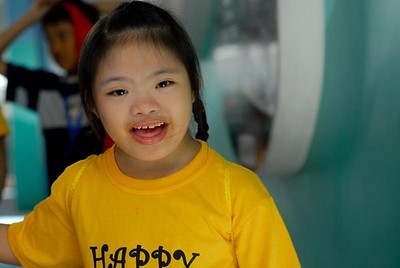9 Intelligence and Measurement
Learning Objectives
After reading Chapter 9, you should be equipped to:
- Compare and contrast the general intelligence and multiple intelligence theories.
- Explain the importance of standardization in the development of psychometric tests.
- Distinguish between the Stanford Binet and Wechsler Intelligence tests.
- How do intellectual disabilities and giftedness represent extremes of intelligence?
- Describe the different types of learning disabilities.
- Explain the relationship between creativity and intelligence.
Intelligence
Classifying Intelligence: One vs. Many
The early 1900s saw Charles Spearman using a mathematical approach to the question of measuring human intelligence. Using statistical factor analysis Spearman identified g, a single underlying intelligence factor he believed accounted for the variety of observable abilities.
Charles Spearman 1863-1945[2]
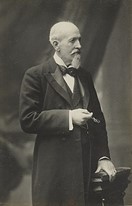
Spearman noticed that children’s grades across all school subjects tended to be highly correlated. If a child did well in one subject, they generally also did well in another subject, and vice versa. What did this say about the nature of intelligence? He devised factor analysis to measure the relationships between seemingly varied cognitive abilities and account for the correlations he saw between scores on different tests.
The result was Spearman’s two-factor theory which attempted to show that all cognitive performance can be explained by two variables: one general ability (g) and the many specific abilities or (s) it gave rise to. Later, however, further analysis showed that g alone was enough to explain the correlations between different tests. When people talk about IQ or intelligence, it’s usually this general mental ability that they are referring to. Today, almost all IQ tests are factor models inspired by Spearman’s work on g. [3]
Charles Spearman’s noted student Raymond Cattell expanded on Spearman’s theory of a unified g and explored the difference between two independent but correlated factors of general intelligence: crystallized intelligence and fluid intelligence, which he called Gc and Gf. [4]
Raymond Cattell 1905-1998[5]
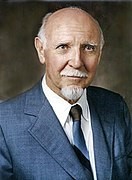
Crystallized intelligence is characterized as acquired knowledge and the ability to retrieve it. When you learn, remember, and recall information, you are using crystallized intelligence. You use crystallized intelligence all the time in your coursework by demonstrating that you have mastered the information covered in the course. Fluid intelligence encompasses the ability to see complex relationships and solve problems. Navigating your way home after being detoured onto an unfamiliar route because of road construction would draw upon your intelligence. Fluid intelligence helps you tackle complex, abstract challenges in your daily life, whereas crystallized intelligence helps you overcome concrete, straightforward problems (Cattell, 1963).[6]
Research demonstrates that older adults have more crystallized intelligence, as reflected in semantic knowledge, vocabulary, and language. As a result, older adults generally outperform younger people on measures of history, geography, and even on crossword puzzles, where this information is useful (Salthouse, 2004). This superior knowledge, combined with a slower and more complete processing style and sophisticated understanding of the workings of the world, gives those older an advantage, despite greater fluid intelligence in those younger (Baltes, Staudinger, & Lindenberger, 1999; Scheibe, Kunzmann, & Baltes, 2009). The differential changes in crystallized versus fluid intelligence also explains why those older do not necessarily show poorer performance on tasks that require experience, although they show poorer memory overall. A young chess player may think more quickly, but a more experienced chess player has more knowledge to draw on.[7]
Triarchic Theory: One advocate of the idea of multiple intelligences is the psychologist Robert Sternberg. Sternberg has proposed a triarchic (three-part) theory of intelligence that proposes that people may display more or less analytical intelligence, creative intelligence, and practical intelligence. [8]
Sternberg (1985, 2003) defined the three intelligences as:
- Analytical intelligence or the ability to perform academic problem solving
- Creative intelligence or the ability to adapt to new situations and create new ideas
- Practical intelligence or the ability to demonstrate street smarts and common sense [9]
Reading supports analytical intelligence. [10]
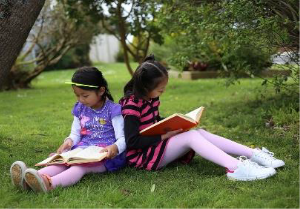
Building supports creative intelligence. [11]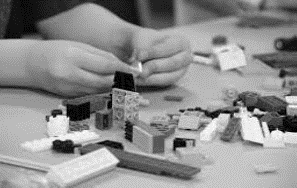
Navigating social situations is practical intelligence. [12]

Sternberg (1985, 2003) argued that traditional intelligence tests assess analytical intelligence, but that they do not typically assess creative intelligence, and/or practical intelligence.[13]
As Sternberg proposed, research has found that creativity is not highly correlated with analytical intelligence (Furnham & Bachtiar, 2008) and exceptionally creative scientists, artists, mathematicians, and engineers do not score higher on intelligence than do their less, creative peers (Simonton, 2000).
Furthermore, the brain areas that are associated with convergent thinking, thinking that is directed toward finding the correct answer to a given problem, are different from those associated with divergent thinking, the ability to generate many different ideas or solutions to a single problem (Tarasova, Volf, & Razoumnikova, 2010). On the other hand, being creative often takes some of the basic abilities measured by “g”, including the abilities to learn from experience, to remember information, and to think abstractly (Bink & Marsh, 2000).
The last aspect of the triarchic model, practical intelligence, refers to intelligence that cannot be gained from books or formal learning. Practical intelligence represents a type of “street smarts” or “common sense” that is learned from life experiences. Although a number of tests have been devised to measure practical intelligence (Sternberg, Wagner, & Okagaki, 1993; Wagner & Sternberg, 1985), research has not found much evidence that practical intelligence is distinct from “g” or that it is predictive of success at any particular tasks (Gottfredson, 2003). Practical intelligence may include, at least in part, certain abilities that help people perform well at specific jobs, and these abilities may not always be highly correlated with general intelligence (Sternberg et al.1993).
Multiple Intelligence Theory – Howard Gardner: Another champion of the idea of specific types of intelligences rather than one overall intelligence is the psychologist Howard Gardner (1983, 1999). Gardner argued that it would be evolutionarily functional for different people to have different talents and skills and proposed that there are eight intelligences that can be differentiated from each other. A potential ninth intelligence; that is, existential still needs empirical support. Gardner investigated intelligences by focusing on children who were talented in one or more areas and adults who suffered from strokes that compromised some capacities, but not others. Gardner also noted that some evidence for multiple intelligences comes from the abilities of autistic savants, people who score low on intelligence tests overall, but who nevertheless may have exceptional skills in a given domain, such as math, music, art, or in being able to recite statistics in a given sport (Treffert & Wallace, 2004). In addition to brain damage and the existence of savants, Gardner identified these 8 intelligences based on other criteria including a set developmental history and psychometric findings. [14]
Howard Gardner (1943)[15]

The first three are skills that are measured by IQ tests:
- Logical-mathematical: the ability to solve mathematical problems; problems of logic, numerical patterns
- Linguistic: vocabulary, reading comprehension, function of language
- Spatial: visual accuracy, ability to read maps, understand space and distance
The next six represent skills that are not measured in standard IQ tests but are talents or abilities that can also be important for success in a variety of fields. These are:
- Musical: ability to understand patterns in music, hear pitches, recognize rhythms and melodies
- Bodily-kinesthetic: motor coordination, grace of movement, agility, strength
- Naturalistic: knowledge of plants, animals, minerals, climate, weather
- Interpersonal: understand the emotion, mood, motivation of others; able to communicate effectively
- Intrapersonal: understanding of the self, mood, motivation, temperament, realistic knowledge of strengths, weaknesses
The potential ninth intelligence is:
- Existential: concern about and understanding of life’s larger questions, meaning of life, or spiritual matters
A high IQ does not always ensure success in life or necessarily indicate that a person has common sense, good interpersonal skills or other abilities important for success [16]
The idea of multiple intelligences has been influential in the field of education, and teachers have used these ideas to try to teach differently to different students. For instance, to teach math problems to students who have particularly good kinesthetic intelligence, a teacher might encourage the students to move their bodies or hands according to the numbers. On the other hand, some have argued that these “intelligences” sometimes seem more like “abilities” or “talents” rather than real intelligence. There is no clear conclusion about how many intelligences there are. Are a sense of humor, artistic skills, dramatic skills, and so forth also separate intelligences? Furthermore, and again demonstrating the underlying power of a single intelligence, the many different intelligences are, in fact, correlated and thus represent, in part, “g” (Brody, 2003).
Measuring Intelligence: Standardization and the Intelligence Quotient
The goal of most intelligence tests is to measure “g”, the general intelligence factor. Good intelligence tests are reliable, meaning that they are consistent over time, and also demonstrate validity, meaning that they actually measure intelligence rather than something else. Because intelligence is such an important individual difference dimension, psychologists have invested substantial effort in creating and improving measures of intelligence, and these tests are now considered the most accurate of all psychological tests. In fact, the ability to accurately assess intelligence is one of the most important contributions of psychology to everyday public life.
Intelligence changes with age. A 3-year-old who could accurately multiply 183 by 39 would certainly be intelligent, but a 25-year-old who could not do so would be seen as unintelligent. Thus, understanding intelligence requires that we know the norms or standards in a given population of people at a given age. The standardization of a test involves giving it to a large number of people at different ages and computing the average score on the test at each age level.
It is important that intelligence tests be standardized on a regular basis, because the overall level of intelligence in a population may change over time. The Flynn Effect refers to the observation that scores on intelligence tests worldwide have increased substantially over the past decades (Flynn, 1999). Although the increase varies somewhat from country to country, the average increase is about 3 IQ points every 10 years. There are many explanations for the Flynn effect, including better nutrition, increased access to information, and more familiarity with multiple-choice tests (Neisser, 1998). Whether people are actually getting smarter, however, is debatable (Neisser, 1997). Most of the increase in IQ occurred during the second half of the 20th century. Recent research has found a reversal of the Flynn effect in several nations around the world, although some nations still show an increase in IQ scores (Dutton, van der Linden, & Lynn, 2016).
Once the standardization has been accomplished, we have a picture of the average abilities of people at different ages and can calculate a person’s mental age, which is the age at which a person is performing intellectually. If we compare the mental age of a person to the person’s chronological age, the result is the Intelligence Quotient (IQ), a measure of intelligence that is adjusted for age. A simple way to calculate IQ is by using the following formula:
IQ = mental age ÷ chronological age × 100.
Thus a 10-year-old child who does as well as the average 10-year-old child has an IQ of 100 (10 ÷ 10 × 100), whereas an 8-year-old child who does as well as the average 10-year-old child would have an IQ of 125 (10 ÷ 8 × 100).
However, most modern intelligence tests are based on the relative position of a person’s score among people of the same age, rather than on the basis of this formula, but the idea of an intelligence “ratio” or quotient” provides a good description of the score’s meaning.[17]
Intelligence Tests
Alfred Binet & Théodore Simon (The Binet-Simon Test) and the Stanford- Binet Intelligence Test
In the early 1900s, the Ministry of Education in France tasked psychologists Alfred Binet and Theodore Simon with devising a way to identify children who were struggling with ordinary class and needed extra attention. The result of their work helped inspire an intelligence test still in use today.
France was making advancements in its education system and intended to reduce the number of struggling children being diverted into asylums. Binet and Simon were appointed to the now unfortunately named Commission for the Retarded, where they became curious about how to study children’s intelligence experimentally. They developed the Binet-Simon scale and made many subsequent adjustments.
Alfred Binet (1857-1911)[18]
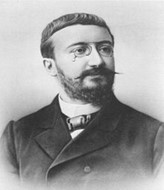
Based on their experience and observations, the pair included thirty questions they believed a child at each age ought to be able to answer. They gave their test to a group of children selected by teachers as being average, to confirm the test as a standard by which other children could be compared. Questions ranged from very easy (name various body parts) to more difficult (find rhyming words or remember a string of numbers). If, for example, a 9-year-old child passed all the questions that most other 9-year-old children passed, they were scored as having a mental age of 9.
Standford-Binet
Lewis Terman (1877-1956)[19]

Lewis Terman standardized the Binet-Simon test for the more diverse American population in 1916, where it flourished as a new tool in a rapidly changing political environment, becoming the Stanford-Binet Intelligence Test. The Stanford-Binet remained America’s most popular test for general intelligence for decades, and in World War I Robert Yerkes worked with both Terman and Goddard to design a controversial test that screened men for training to become officers.[20]
Sample practice question on the Stanford-Binet V.
![Sample practice question on the Stanford-Binet V. The child is asked to identify the picture. A bike or bicycle would be the correct answer. <a class="footnote" title="Image retrieved from NYC Gifted and Talented Program and Testing Blog - public domain" id="return-footnote-131-1" href="#footnote-131-1" aria-label="Footnote 1"><sup class="footnote">[1]</sup></a>](https://pressbooks.cuny.edu/app/uploads/sites/16/2022/04/Picture5-3.jpg)
The child is asked to identify the picture. A bike or bicycle would be the correct answer. [21]
Wechsler Scales of Intelligence
David Wechsler (1896-1981) [22]
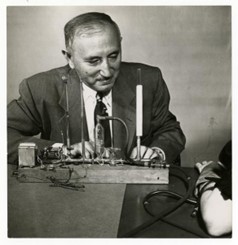
A number of scales are based on IQ. The Wechsler Adult Intelligence Scale (WAIS) is the most widely used intelligence test for adults (Watkins, Campbell, Nieberding, & Hallmark, 1995). The current version of the WAIS, the WAIS-IV, was standardized on 2,200 people ranging from 16 to 90 years of age. It consists of 15 different tasks, each designed to assess intelligence, including working memory, arithmetic ability, spatial ability, and general knowledge about the world. The WAIS-IV yield scores on four domains: verbal, perceptual, working memory, and processing speed. The reliability of the test is high (more than 0.95), and it shows substantial construct validity. The WAIS-IV is correlated highly with other IQ tests such as the Stanford-Binet, as well as with criteria of academic and life success, including college grades, measures of work performance, and occupational level. It also shows significant correlations with measures of everyday functioning among people with intellectual disabilities.
The Wechsler scale has also been adapted for preschool children in the form of the Wechsler Primary and Preschool Scale of Intelligence-Fourth Edition (WPPSI-IV) and for older children and adolescents in the form of the Wechsler Intelligence Scale for Children-Fifth Edition (WISC-V).[23]
The WPPSI-IV is an individually administered intelligence test designed for children aged 2 years and 6 months to 7 years and 7 months. It does not measure academic achievement or “school” skills. Rather, it attempts to predict what a child might be capable of, given an ideal set of circumstances. The actual realization of skills is dependent upon adequate educational opportunities, experience, and exposure. The WPPSI-IV is composed of a variety of individually administered subtests, each of which measures a specific area of cognitive ability. The subtests are grouped into categories, and the scores are presented as percentiles, not percentages. The subtests on the WPPSI-IV alternate between verbal and nonverbal tasks.[24]
The WISC-V is composed of 10 subtests, which comprise four indices, which then render an IQ score. The four indices are Verbal Comprehension, Perceptual Reasoning, Working Memory, and Processing Speed. When the test is complete, individuals receive a score for each of the four indices and a Full-Scale IQ score (Heaton, 2004). The method of scoring reflects the understanding that intelligence is comprised of multiple abilities in several cognitive realms and focuses on the mental processes that the child used to arrive at his or her answers to each test item Heaton, 2004).[25]
Potential Bias of Intelligence Testing
Intelligence tests and psychological definitions of intelligence have been heavily criticized since the 1970s for being biased in favor of Anglo-American, middle-class respondents and for being inadequate tools for measuring non-academic types of intelligence or talent. Intelligence changes with experience, and intelligence quotients or scores do not reflect that ability to change. What is considered smart varies culturally as well, and most intelligence tests do not take this variation into account. For example, in the West, being smart is associated with being quick. A person who answers a question the fastest is seen as the smartest, but in some cultures being smart is associated with considering an idea thoroughly before giving an answer. A well-thought-out, contemplative answer is the best answer.
Extremes of Intelligence: Intellectual Disability and Giftedness
The results of studies assessing the measurement of intelligence show that IQ is distributed in the population in the form of a normal distribution (or bell curve), which is the pattern of scores usually observed in a variable that clusters around its average. In a normal distribution, the bulk of the scores fall toward the middle, with fewer scores falling at the extremes. The normal distribution of intelligence shows that on IQ tests, as well as on most other measures, the majority of people cluster around the average (in this case, where IQ = 100), and fewer are either very smart or very dull (see Figure 5.13). Because the standard deviation of an IQ test is about 15, this means that about 2% of people score above an IQ of 130, often considered the threshold for giftedness, and about the same percentage score below an IQ of 70, often being considered the threshold for an intellectual disability.
Normal Distribution of Intelligence Scores
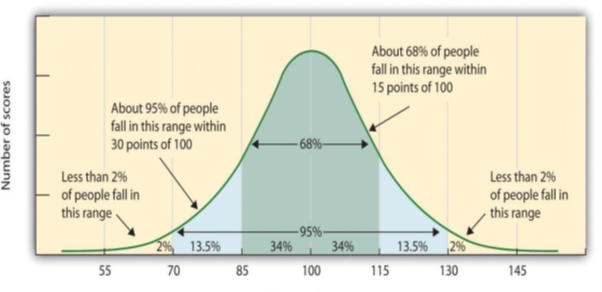
The normal distribution of IQ scores in the general population shows that most people have about average intelligence, while very few have extremely high or extremely low intelligence. [26]
Intellectual Disability Disorder
The normal distribution of IQ scores in the general population shows that most people have about average intelligence, while very few have extremely high or extremely low intelligence. One end of the distribution of intelligence scores is defined by people with very low IQ.
According to the DSM-5-TR, intellectual disability disorder is a disorder with onset during the developmental period that includes both intellectual and adaptive functioning deficits in conceptual, social, and practical domains. The following three criteria must be met:
- Deficits in intellectual functions, such as reasoning, problem-solving, planning, abstract thinking, judgment, academic learning, and learning from experience, confirmed by both clinical assessment and individualized, standardized intelligence testing.
- Deficits in adaptive functioning that result in failure to meet developmental and sociocultural standards for personal independence and social responsibility. Without ongoing support, the adaptive deficits limit functioning in one or more activities of daily life, such as communication, social participation, and independent living, across multiple environments, such as home, school, work, and community.
- The onset of intellectual and adaptive deficits during the developmental period.”[27]
Four levels of severity have been identified for intellectual Disability Disorder: Mild, Moderate, Profound, and Severe. The identification of severity level is based on adaptive functioning and not IQ scores. One reason is that the scores on a children’s adaptive functioning scale determine the levels of support required for that child. Second, IQ scores become less valid in the lower end of the IQ range. [28]
Down Syndrome
One cause of intellectual developmental disorder is Down syndrome, a chromosomal disorder caused by the presence of all or part of an extra 21st chromosome. The incidence of Down syndrome is estimated at 1 per 800 to 1,000 births, although its prevalence rises sharply in those born to older mothers. People with Down syndrome typically exhibit a distinctive pattern of physical features, including a flat nose, upwardly slanted eyes, a protruding tongue, and a short neck.[29]
This child exhibits some of the distinct facial characteristics of Down Syndrome. [30]
Fetal Alcohol Spectrum Disorder
Fetal Alcohol Spectrum Disorders are another cause of intellectual disability. This spectrum of disorders (FASD) is a group of conditions that can occur in a person whose mother ingested alcohol during pregnancy. Fetal alcohol syndrome (FAS) is the most severe disorder on this spectrum, and it is the leading cause of intellectual disability. This syndrome is caused when alcohol crosses the barrier of the placenta in a pregnant woman and damages the developing brain of the fetus. Alcohol exposure presents a risk of fetal brain damage at any point during a pregnancy since brain development is ongoing throughout pregnancy. FASD is estimated to affect between 2% and 5% of people in the United States and Western Europe. FAS is believed to occur in between 0.2 and 9 per 1000 live births in the United States.[31]
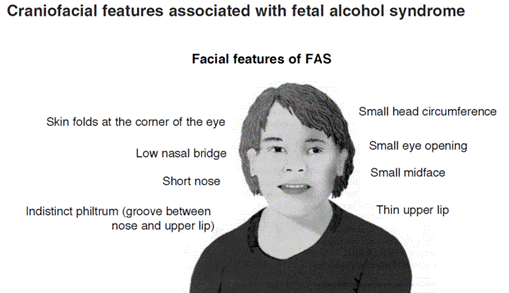
Diagram and Description of Adolescent with Fetal Alcohol Syndrome [32]
An adolescent with Fetal Alcohol Syndrome. [33]

Common Signs of Intellectual Disability
Usually, the more severe the degree of intellectual disability, the earlier the signs can be noticed. However, it might still be hard to tell how young children will be affected later in life. There are many signs of intellectual disability. For example, children with intellectual disability may:
-
- sit up, crawl, or walk later than other children
- learn to talk later, or have trouble speaking
- find it hard to remember things
- have trouble understanding social rules
- have trouble seeing the results of their actions
- have trouble solving problems [34]
Giftedness
Giftedness refers to children who have an IQ of 130 or higher (Lally & Valentine-French, 2015). Having an extremely high IQ is clearly less of a problem than having an extremely low IQ, but there may also be challenges to being particularly smart. It is often assumed that schoolchildren who are labeled as “gifted” may have adjustment problems that make it more difficult for them to create social relationships. To study gifted children, Lewis Terman and his colleagues (Terman & Oden, 1959) selected about 1,500 high school students who scored in the top 1% on the Stanford-Binet and similar IQ tests (i.e., who had IQs of about 135 or higher), and tracked them for more than seven decades (the children became known as the “termites” and are still being studied today). This study found that these students were not unhealthy or poorly adjusted, but rather were above average in physical health and were taller and heavier than individuals in the general population. The students also had above-average social relationships and were less likely to divorce than the average person (Seagoe, 1975).
Terman’s study also found that many of these students went on to achieve high levels of education and entered prestigious professions, including medicine, law, and science. Of the sample, 7% earned doctoral degrees, 4% earned medical degrees, and 6% earned law degrees. These numbers are all considerably higher than what would have been expected from a more general population. Another study of young adolescents who had even higher IQs found that these students ended up attending graduate school at a rate more than 50 times higher than that in the general population (Lubinski & Benbow, 2006).
As you might expect based on our discussion of intelligence, kids who are gifted have higher scores on general intelligence “g”, but there are also different types of giftedness. Some children are particularly good at math or science, some at automobile repair or carpentry, some at music or art, some at sports or leadership, and so on. There is a lively debate among scholars about whether it is appropriate or beneficial to label some children as “gifted and talented” in school and to provide them with accelerated special classes and other programs that are not available to everyone. Although doing so may help the gifted kids (Colangelo & Assouline, 2009), it also may isolate them from their peers and make such provisions unavailable to those who are not classified as “gifted.”[35]
Benefits of Gifted Programs
Gifted children often learn faster than their peers, and work more independently. Since their academic achievement is advanced, these students may become bored in a traditional classroom setting. This can sometimes lead to behavioral problems or lack of motivation. Schools face the challenge of how to work with gifted students academically to keep them challenged and engaged.
One way schools may handle this issue is to allow a gifted child to skip grades. The advantage to this solution is that the child will be doing coursework that is appropriate to their cognitive level. The potential disadvantages, however, are substantial: younger students will experience physical development later than their grade-level peers and may experience emotional development later as well. This may lead them to feel self-conscious about being different or to be bullied by their peers.
Another solution is to keep the child in the regular classroom but provide additional assignments and an enriched curriculum. In addition to the enriched curriculum, another option might be pull-out programs where the child leaves the classroom during certain times or days for advanced classes. Finally, some school districts create entire gifted classrooms.
Gifted programs can be beneficial to the gifted child by keeping the child engaged in learning. Some programs even offer gifted children college-level credit for advanced placement classes (with a passing grade on an assessment test). These programs can provide the child with opportunities to discover his or her potential.
Disadvantages of Gifted Programs
Gifted programs can also be detrimental to children. By labeling some children as “gifted” and others as “not gifted,” schools can create a self-fulfilling prophecy where those who are not accepted into the program do not perform as well as those who are accepted. The students identified as “not gifted” may believe they are not as intelligent as those who are labeled gifted, and in turn, they may not put forth the same effort at school. The Pygmalion Effect is a studied phenomenon in which higher expectations lead to better performance; the golem effect is the opposite phenomenon, in which lower expectations lead to lower performance. Teachers who are told their students are gifted will treat them as though they are gifted, which can result in increased performance; teachers who are told their students are “average” may be less patient when those students struggle than would be if they thought those students were gifted.
Another detriment to gifted programs is that students who are not identified as gifted are denied the benefits of enriched education. Gifted programs vary widely in what they offer, but some involve activities like field trips, talks from scholars, or cultural experiences, like visits to museums. These enrichment activities would benefit all children, not just the gifted.[36]
Children with Learning Disabilities
A learning disability (or LD) is a specific impairment of academic learning that interferes with a specific aspect of schoolwork and that reduces a student’s academic performance significantly. An LD shows itself as a major discrepancy between a student’s ability and some features of achievement: The student may be delayed in reading, writing, listening, speaking, or doing mathematics, but not in all of these at once. A learning problem is not considered a learning disability if it stems from physical, sensory, or motor handicaps, or from generalized intellectual impairment. It is also not an LD if the learning problem really reflects the challenges of learning English as a second language. Genuine LDs are the learning problems left over after these other possibilities are accounted for or excluded. Typically, a student with an LD has not been helped by teachers’ ordinary efforts to assist the student when he or she falls behind academically, though what counts as an “ordinary effort”, of course, differs among teachers, schools, and students. Most importantly, though, an LD relates to a fairly specific area of academic learning. A student may be able to read and compute well enough, for example, but not be able to write. LDs are by far the most common form of special educational need, accounting for half of all students with special needs in the United States and approximately 20% of all students, depending on how the numbers are estimated (National Center for Learning Disabilities, 2017). Students with LDs are so common, in fact, that most teachers regularly encounter at least one per class in any given school year, regardless of the grade level they teach. These difficulties are identified in school because this is when children’s academic abilities are being tested, compared, and measured. Consequently, once academic testing is no longer essential in that person’s life (as when they are working rather than going to school) these disabilities may no longer be noticed or relevant, depending on the person’s job and the extent of the disability.
Types of Learning Disabilities
Dyslexia is one of the most commonly diagnosed disabilities and involves having difficulty in the area of reading. This diagnosis is used for a number of reading difficulties. Common characteristics are difficulty with phonological processing, which includes the manipulation of sounds, spelling, and rapid visual/verbal processing. Additionally, the child may reverse letters, have difficulty reading from left to right, or may have problems associating letters with sounds. It appears to be rooted in neurological problems involving the parts of the brain active in recognizing letters, verbally responding, or manipulating sounds. Recent studies have identified a number of genes that are linked to developing dyslexia (National Institute of Neurological Disorders and Stroke, 2016). Treatment typically involves altering teaching methods to accommodate the person’s particular problematic area.
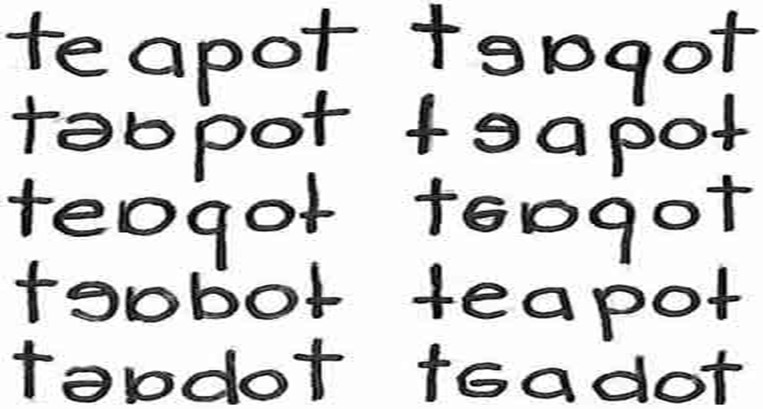
These written words show variations of the word “teapot” as written by individuals with dyslexia. [37]
Dysgraphia refers to a writing disability that is often associated with dyslexia (Carlson, 2013). There are different types of dysgraphia, including phonological dysgraphia when the person cannot sound out words and write them phonetically. Orthographic dysgraphia is demonstrated by those individuals who can spell regularly spelled words, but not irregularly spelled ones. Some individuals with dysgraphia experience difficulties in motor control and experience trouble forming letters when using a pen or pencil.
Dyscalculia refers to problems in math. Cowan and Powell (2014) identified several terms used when describing difficulties in mathematics including dyscalculia, mathematical learning disability, and mathematics disorder. All three terms refer to students with average intelligence who exhibit poor academic performance in mathematics. When evaluating a group of third graders, Cowan and Powell (2014) found that children with dyscalculia demonstrated problems with working memory, reasoning, processing speed, and oral language, all of which are referred to as domain-general factors. Additionally, problems with multi-digit skills, including number system knowledge, were also exhibited.[38]
Children who have motor skills substantially below what is expected for their age are diagnosed with dyspraxia – or developmental coordination disorder DCD) as it is more formally known. They are not lazy, clumsy, or unintelligent – in fact, their intellectual ability is in line with the general population – but they do struggle with everyday tasks that require coordination.
A processing deficit in the auditory modality that spans multiple processes is auditory processing disorder (APD). To date, APD diagnosis is mostly based on the utilization of speech material. Unfortunately, acceptable non-speech tests that allow differentiation an actual central hearing disorder and related disorders such as specific language impairments are still not adequately available.
Difficulty processing or interpreting visual information is referred to as visual processing disorder (VPD). Kids with visual processing issues may have difficulty telling the difference between two shapes or finding a specific piece of information on a page.[39]
Children with Disabilities: Legislation
Since the 1970s political and social attitudes have moved increasingly toward including people with disabilities into a wide variety of “regular” activities. In the United States, the shift is illustrated clearly in the Federal legislation that was enacted during this time. Three major laws were passed that guaranteed the rights of persons with disabilities, and of children and students with disabilities in particular. The third law has had the biggest impact on education.
Rehabilitation Act of 1973, Section 504: This law, the first of its kind, required that individuals with disabilities be accommodated in any program or activity that receives Federal funding (PL 93-112, 1973). Although this law was not intended specifically for education, in practice it has protected students’ rights in some extra-curricular activities for older students) and in some child care or after-school care programs (for younger students). If those programs receive Federal funding of any kind, the programs are not allowed to exclude children or youths with disabilities, and they have to find reasonable ways to accommodate the individuals’ disabilities.
Americans with Disabilities Act of 1990 (or ADA): This legislation also prohibited discrimination on the basis of disability, just as Section 504 of the Rehabilitation Act had done (PL 101-336, 1990). Although the ADA also applies to all people (not just to students), its provisions are more specific and “stronger” than those of Section 504. In particular, ADA extends to all employment and jobs, not just those receiving Federal funding. It also specifically requires accommodations to be made in public facilities such as with buses, restrooms, and telephones. ADA legislation is therefore responsible for some of the “minor” renovations in schools that you may have noticed in recent years, like wheelchair-accessible doors, ramps, and restrooms, and public telephones with volume controls.
Individuals with Disabilities Education Act (or IDEA): As its name implied, this legislation was more focused on education than either Section 504 or ADA. It was first passed in 1975, reauthorized in 2004 (PL 108-446, 2004), and most recently amended in 2015 through Public Law 114-95, as the Every Student Succeeds Act (United States Department of Education, 2017). In its current form, the law guarantees the following rights related to education for anyone with a disability from birth to age 21. The first two influence schooling in general, but the last three affect the work of classroom teachers rather directly: •
- Free, appropriate education: An individual or an individual’s family should not have to pay for education simply because the individual has a disability, and the educational program should be truly educational; i.e., not merely care-taking or babysitting the person.
- Due process: In case of disagreements between an individual with a disability and the schools or other professionals, there must be procedures for resolving the disagreements that are fair and accessible to all parties, including the person himself or herself or the person’s representative.
- Fair evaluation of performance in spite of disability: Tests or other evaluations should not assume test taking skills that a person with a disability cannot reasonably be expected to have, such as holding a pencil, hearing or seeing questions, working quickly, or understanding and speaking orally. Evaluation procedures should be modified to allow for these differences. This provision of the law applies both to evaluations made by teachers and to school-wide or “high-stakes” testing programs.
- Education in the “least restrictive environment”: Education for someone with a disability should provide as many educational opportunities and options for the person as possible, both in the short term and in the long term. In practice this requirement has meant including students in regular classrooms and school activities as much as possible, though often not totally.
- An individualized educational program (IEP): Given that every disability is unique, instructional planning for a person with a disability should be unique or individualized as well. In practice this provision has led to classroom teachers planning individualized programs jointly with other professionals (like reading specialists, psychologists, or medical personnel) as part of a team.
Evaluation and diagnosis can be the first step in helping provide children with disabilities the type of instruction and resources that will benefit them educationally, but diagnosis and labeling also have social implications. It is important to consider that children can be misdiagnosed and that once a child has received a diagnostic label, the child, teachers, and family members may tend to interpret actions of the child through that label. The label can also influence the child’s self-concept. Consider, for example, a child who is misdiagnosed as learning disabled. That child may expect to have difficulties in school, lack confidence, and because of these expectations experience trouble. This self-fulfilling prophecy or tendency to act in such a way as to make what you predict will happen, will come true. This calls our attention to the power that labels can have whether or not they are accurately applied. It is also important to consider that children’s difficulties can change over time; a child who has problems in school, may improve later or may live under circumstances as an adult where the problem (such as a delay in math skills or reading skills) is no longer relevant. That person, however, will still have a label as learning disabled. It should be recognized that the distinction between abnormal and normal behavior is not always clear; some abnormal behavior in children is fairly common.[40]
Creativity and Intelligence
Models of Creativity
A general definition of creativity describes it as the ability to generate ideas, insights, and solutions that are original, flexible (Amabile, 1996; Sternberg and Lubart, 1996) and effective (Runco and Jaeger, 2012). A vast body of research has been conducted in this field from different points of view (psychological, pedagogical, educational, etc.). In brief, creativity can be understood as the combination of several factors (Treffinger et al., 1983; Houtz and Krug, 1995a, b) of both a cognitive (primarily related to divergent thinking) and an emotional type (primarily related to creative personality). On the cognitive side, there is a general convergence on the notion that creative outputs result from cognitive flexibility (flexible and divergent ways of thinking) and cognitive persistence (persistent and systematic way of thinking) (see Dietrich and Kanso, 2010). On the emotional side, Williams (1994) explored the emotional-divergent aspect of creativity, identifying the main characteristics of personality as (1) curiosity (the capacity to investigate elements and ideas, finding new and not always direct and obvious connections); (2) complexity (the tendency to look for new alternatives and solutions to problems, to restore order out of chaos); (3) imagination (the ability to visualize mental images); (4) risk-taking (the inclination to act unstructured conditions and to defend one’s own ideas).
Creativity can be also seen as the result of interaction between the individual, the domain, and the field. For instance, Rhodes (1961, 1987) developed the 4 P’s model which places creativity at the interplay of four distinct strands, i.e., process (the different stages of a creative activity), the person (the characteristics of individuals), press (the qualities of the environment where creativity happens), and product (the tangible or intangible outcomes of the creative process). Rhodes’ classification has become a major framework for the holistic exploration of creativity.[41]
However, creativity is not only the production of something new for the entire society (like arts): creativity is often found in an individual’s everyday activities. In this sense, the literature defines two types of creativity: Creativity and creativity. “Capital C” creativity brings into existence something genuinely new that receives social validation (enhances culture) and is related to an accomplishment that consists of a clear-cut, eminent creative contribution. “Small C” creativity refers to ideas or products that are new to the person, but only to the person; it is, therefore, more focused on everyday activities, such as those creative actions in which everyone can be involved every day. Kaufman and Beghetto (2009) add another 2 Cs to their model, including a new category, a “little-c” for the little-c category, mini-c (Beghetto and Kaufman, 2007), which is connected with the learning process. Mini-C is defined as the novel and personally meaningful interpretation of experiences, actions, and events (Beghetto and Kaufman, 2007). Together with Mini-c, they introduce Pro-c, the developmental and effortful progression beyond little-c, not reaching Big-C status, on professional-level expertise in creative areas. The 5 A’s framework (Glãveanu, 2013) goes beyond the 4 P’s model to give a new perspective on creativity: it introduces actor, action, artifact, audience, and affordances.[42]
Two Models of Creativity [43]
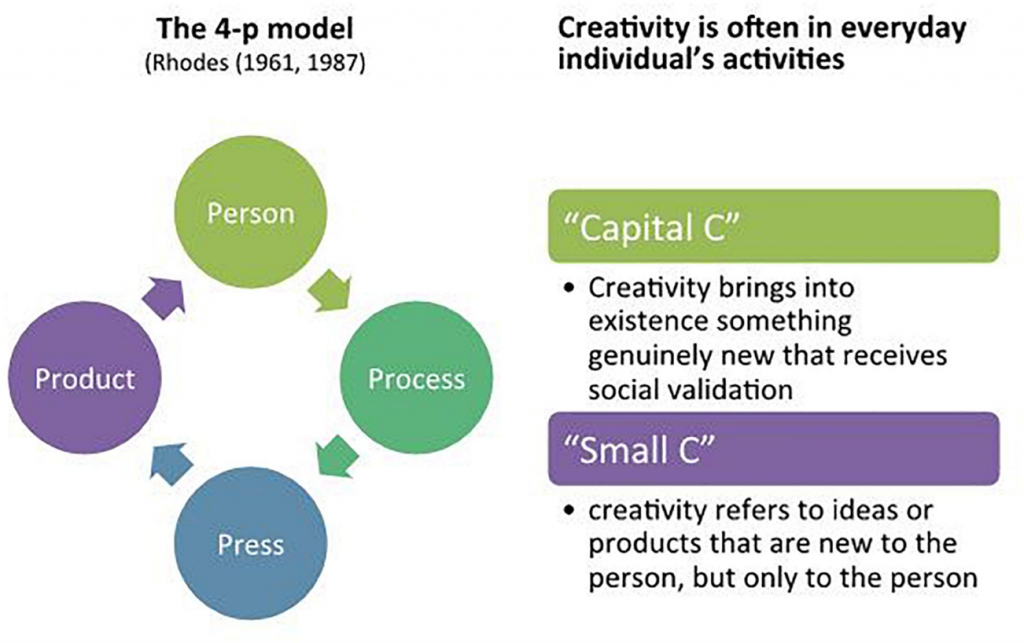
Measures of Creativity
According to Guilford (1967), the core of creativity is divergent thinking (DT), which is the ability of an individual to generate as many answers as possible to a problem. As a result, DT tasks have long been employed to evaluate people’s creativity (Sayed and Mohamed, 2013), and DT tests have become the most popular psychometric assessment tools in creativity research fields (Acar and Runco, 2014). Previous studies indicate that tests of DT are reliable and valid predictors of certain creative performance criteria, although they do not guarantee actual creative achievement (Runco and Acar, 2012). However, they are effective measurements to assess creative ability (Colzato et al., 2012). As one of the most well-constructed tests to assess creativity (Zhu et al., 2013), the Torrance Test of Creative Thinking (TTCT) is often employed in studies and it is widely given to elementary students to assess their creativity.[44]
Creativity From a Developmental Point of View
From what we said, it is clear that creativity can also be seen as a cognitive resource along the “life-span,” starting from childhood. Indeed, children tend to exhibit a natural disposition toward creativity and expression; fluency (the ability to generate multiple ideas) and flexibility develop across distinct trajectories for divergent thinking and insight (Kleibeuker et al., 2013), explorative thinking characterizes middle adolescence (Johnson and Wilbrecht, 2011). Moreover, children can be sensitive to creativity outcomes from 3 years of age, which is quite early (Di Dio et al., 2007), and this sensitivity can enable them to develop their creative side. In children with atypical developmental trajectories, creativity can offer support for adaptive processes (Hetzroni et al., 2019). If not stimulated, creativity can diminish. For instance, creativity diminishes by 40% between the ages of five and seven. This is due to the beginning of formal schooling with its educational rules which may inhibit commitment to creative thinking and behaviors (Amabile, 1996; McCormick and Plugge, 1997). New research has also led to a new understanding of the capacity for positive change and creative expression in the second half of life (Cohen, 2006). In general terms, psychological literature has highlighted that creativity can be interpreted as an individual resource, as a potent predictor of social problem-solving and adjustment (Ogoemeka, 2011). In other words, creative individuals are remarkable for their ability to adapt to almost any situation and exploit whatever possible to reach their goals (Csikszentmihalyi, 1996).
The paths to support individual development do not always consider creativity as a useful resource for well-being, despite research providing evidence to this effect. The role of creativity as a resource for individual well-being was identified: creativity and learning are strictly connected not only during childhood but also during young adulthood and adulthood (see Gajda et al., 2017). Long-term participation in creative activities has benefits for middle-aged and older people as they may improve their adaptation to later life (Adams-Price et al., 2018).[45]
Relationship between Intelligence and Creativity
There have been different conceptualizations regarding the relationship between intelligence and creativity However, of all explanations, the threshold hypothesis (Getzels and Jackson, 1962; Guilford, 1967; Fuchs-Beauchamp et al., 1993) is a classical and notable hypothesis. According to this theory, the relationship between creativity and intelligence may vary at different levels of intelligence. Guilford and Christensen (1973) assumed a break in the correlation data between intelligence quotient (IQ) and creativity at an IQ level of approximately 120. Below an IQ level of 120, a correlation between IQ and creativity is observed, whereas no correlation is observed at IQ levels above 120. However, the results of other research yielded inconsistent results. Through the study of a gifted sample, Barron (1963, 1969) observed intelligence had no significant correlation with creativity but a significant correlation did exist in a sample of average intelligence. Schubert (1973) and Weinstein and Bobko (1980) discovered that the relationship between intelligence and creativity varies with different levels of IQ and intelligence has a weaker correlation with creativity in the top half of the intelligence range than in the bottom half of the intelligence range. In addition, with a sample of 338 gifted (IQ ≥ 130) and 220 non-gifted (IQ < 130) 7.8–14-year-old children, Guignard et al. (2016) indicated that the threshold effect was only found for correlations between verbal integrative thinking and perceptual reasoning or processing speed. In contrast to these points, some studies provide evidence that does not support the threshold hypothesis. For example, Runco and Albert (1986) used California Achievement Test (CAT) scores as the estimate of intelligence and discovered that the coefficient between divergent thinking (DT) and the CAT was very significant in the high ability group with fifth to eighth-grade students; this result refuted the threshold hypothesis. Preckel et al. (2006) examined the relationship between DT and fluid intelligence with a sample of 1328 German 12–16 years old students and discovered that correlations between both variables are almost equal at different IQ levels. Nevertheless, in a more recent study with a sample of Chinese elementary school children, Baoguo Shi et al., (2017) found support for the threshold hypothesis.
Another matter regarding the threshold hypothesis has to do with the IQ break point. As mentioned previously, research by Guilford and Christensen (1973) assumed that the break IQ level is approximately 120. However, the results of research utilizing children of different age groups indicate that different thresholds exist within different age groups. For example, Karwowski and Gralewski (2013) observed a threshold of 115 IQ points in a sample of Polish middle school students after applying item response theory and confirmatory factor analysis. Jauk et al. (2013) examined the threshold of intelligence in a sample of adult participants by segmented regression analysis and obtained a threshold of 104.00 (or 119.60) IQ points for the originality of two (or many) original ideas and a threshold of 86.09 IQ points for ideational fluency. For a particularly advanced indicator such as creative achievement, no threshold effect was observed, which suggests that intelligence is linked with creative achievement across the entire IQ range. Mourgues et al. (2016) explored the threshold theory with 4368 third to eleventh-grade Saudi Arabian students. Only for sixth to eighth (108.8) graders and ninth to eleventh (108.4) graders the thresholds were detected. Baoguo Shi et al., (2017) found breakpoints around 110 IQ level in their sample of elementary school children.
Welter et al.(2016) contend that the association between intelligence and creativity is not straightforward and is dependent on a combination of factors, including grade level and gender. Overall, the evidence suggests that intelligence is necessary for creativity but not sufficient.[46]
Testing in Schools
Children’s academic performance is often measured with the use of standardized tests. Those tests include but are not limited to Achievement and Aptitude tests.
Achievement tests are used to measure what a child has already learned. Achievement tests are often used as measures of teaching effectiveness within a school setting and as a method to make schools that receive tax dollars (such as public schools, charter schools, and private schools that receive vouchers) accountable to the government for their performance.
Aptitude tests are designed to measure a student’s ability to learn or to determine if a person has potential in a particular program. These are often used at the beginning of a course of study or as part of college entrance requirements. The Scholastic Aptitude Test (SAT) and Preliminary Scholastic Aptitude Test (PSAT) are perhaps the most familiar aptitude tests to students in grades 6 and above. Learning test-taking skills and preparing for SATs has become part of the training that some students in these grades receive as part of their pre-college preparation. Other aptitude tests include the MCAT (Medical College Admission Test), the LSAT (Law School Admission Test), and the GRE (Graduate Record Examination). Intelligence tests are also a form of an aptitude test, which are designed to measure a person’s ability to learn.[47]
What Happened to No Child Left Behind?
In 2001, President Bush signed into effect Public Law 107-110, better known as the No Child Left Behind Act mandating that schools administer achievement tests to students and publish those results so that parents have an idea of their children’s performance. Additionally, the government would have information on the gaps in educational achievement between children from various social classes, racial, and ethnic groups.
Schools that showed significant gaps in these levels of performance were mandated to work toward narrowing these gaps. Educators criticized the policy for focusing too much on testing as the only indication of student performance. Target goals were considered unrealistic and set by the federal government rather than individual states. Because these requirements became increasingly unworkable for schools, changes to the law were requested. On December 12, 2015, President Obama signed into law the Every Student Succeeds Act (ESSA). This law is state-driven and focuses on expanding educational opportunities and improving student outcomes, including in the areas of high school graduation, drop-out rates, and college attendance.[48]
- Image retrieved from NYC Gifted and Talented Program and Testing Blog - public domain ↵
- Image from Wikimedia Commons licensed under Library of Congress. Image is public domain. ↵
- Spearman and the theory of general intelligence by Lyndsay T Wilson was retrieved from Explorable.com is licensed under CC BY 4.0 ↵
- Fluid and Crystallized Intelligence by Lyndsay T Wilson was retrieved from Explorable.com is licensed under CC BY 4.0 ↵
- Image from Wikimedia Commons is licensed under CC BY SA 3.0 ↵
- Introduction to Psychology – Thinking and Intelligence by Lumen Learning is licensed under CC BY 4.0 (modified by Marie Parnes) ↵
- Introduction to Psychology Adapted by Martha Lally and Suzanne Valentine-French is licensed under CC BY-NC-SA 3.0 ↵
- Lifespan Development: A Psychological Perspective 2nd Edition by Martha Lally and Suzanne Valentine-French is licensed under CC BY-NC-SA 3.0 (modified by Marie Parnes) ↵
- Introduction to Psychology Adapted by Martha Lally and Suzanne Valentine-French is licensed under CC BY-NC-SA 3.0 ↵
- Image licensed under CC0 from Child Growth and Development: An Open Educational Resources Publication by College of the Canyons by Jennifer Paris, Antoinette Ricardo, and Dawn Richmond is licensed under CC BY 4.0 ↵
- Image by Steven Depolo is licensed under CC-BY-2.0 Child Growth and Development: An Open Educational Resources Publication by College of the Canyons by Jennifer Paris, Antoinette Ricardo, and Dawn Richmond is licensed under CC BY 4.0 ↵
- Image by Steven Depolo is licensed under CC-BY-2.0 Child Growth and Development: An Open Educational Resources Publication by College of the Canyons by Jennifer Paris, Antoinette Ricardo, and Dawn Richmond is licensed under CC BY 4.0 ↵
- Lifespan Development: A Psychological Perspective 2nd Edition by Martha Lally and Suzanne Valentine-French is licensed under CC BY-NC-SA 3.0 (modified by Marie Parnes) ↵
- Lifespan Development: A Psychological Perspective 2nd Edition by Martha Lally and Suzanne Valentine-French is licensed under CC BY-NC-SA 3.0 (modified by Marie Parnes) ↵
- Image from Wikimedia is licensed under CC BY 3.0 ↵
- [12] Lifespan Development - Module 5: Early Childhood by Lumen Learning references Psyc 200 Lifespan Psychology by Laura Overstreet, licensed under CC BY 4.0 (modified by Marie Parnes) ↵
- Child Growth and Development: An Open Educational Resources Publication by College of the Canyons by Jennifer Paris, Antoinette Ricardo, and Dawn Richmond is licensed under CC BY 4.0 ↵
- Image of Alfred Binet is public domain. ↵
- Image from Wikimedia Commons is public domain. ↵
- Binet and the First IQ Test by Lyndsay T Wilson was retrieved from Explorable.com and is licensed under CC BY 4.0 ↵
- Image retrieved from NYC Gifted and Talented Program and Testing Blog - public domain ↵
- Image from Wikimedia Commons is licensed under CC BY 4.0 ↵
- Lifespan Development: A Psychological Perspective 2nd Edition by Martha Lally and Suzanne Valentine-French is licensed under CC BY-NC-SA 3.0 (modified by Marie Parnes) ↵
- Private School Testing: What ls the WPPSI-IV? How do Schools Use it? by Valerie Slattery, Ph.D retrieved from Lowell School blog – public domain ↵
- Introduction to Psychology – Thinking and Intelligence by Lumen Learning is licensed under CC BY 4.0 (modified by Marie Parnes) ↵
- Lifespan Development: A Psychological Perspective 2nd Edition by Martha Lally and Suzanne Valentine-French is licensed under CC BY-NC-SA 3.0. ↵
- Diagnostic and Statistical Manual of Mental Disorders: Fifth Edition Text Revision DSM-5-TR™, | American Psychiatric Association,https://ebooks.appi.org/epubreader/diagnostic-statistical-manual-mental-disorders-fifth-edition-text-revision-dsm5tr ↵
- "39"-Diagnostic and Statistical Manual of Mental Disorders: Fifth Edition Text Revision DSM-5-TR™, | American Psychiatric Association,https://ebooks.appi.org/epubreader/diagnostic-statistical-manual-mental-disorders-fifth-edition-text-revision-dsm5tr ↵
- Lifespan Development: A Psychological Perspective 2nd Edition by Martha Lally and Suzanne Valentine-French is licensed under CC BY-NC-SA 3.0. (modified by Marie Parnes) ↵
- Image Happy Walk 05 by Ray Leyesa is licensed under CC BY-NC-ND 2.0 ↵
- Intellectual Disabilities Boundless Psychology. Curation and Revision. Provided by: Boundless.com licensed by CC BY-SA 4.0 ↵
- Image from Wikimedia. Licensed under public domain from the NIH/National Institute on Alcohol Abuse and Alcoholism. ↵
- Image from Wikimedia. Licensed under public domain from the NIH/National Institute on Alcohol Abuse and Alcoholism. ↵
- Facts About Intellectual Disabilities from the CDC is public domain. ↵
- Lifespan Development: A Psychological Perspective 2nd Edition by Martha Lally and Suzanne Valentine-French is licensed under CC BY-NC-SA 3.0. ↵
- The Intellectually Gifted Boundless Psychology. Curation and Revision. Provided by: Boundless.com licensed by CC BY-SA 4.0 ↵
- Image from The Source of Intelligence by Openstax is licensed under CC-BY-4.0 ↵
- Lifespan Development: A Psychological Perspective 2nd Edition by Martha Lally and Suzanne Valentine-French is licensed under CC BY-NC-SA 3.0 . ↵
- Child Growth and Development: An Open Educational Resources Publication by College of the Canyons by Jennifer Paris, Antoinette Ricardo, and Dawn Richmond is licensed under CC BY 4.0 (MODIFIED BY Marie Parnes) ↵
- Lifespan Development: A Psychological Perspective 2nd Edition by Martha Lally and Suzanne Valentine-French is licensed under CC BY-NC-SA 3.0 . ↵
- On the Edge Between Digital and Physical: Materials to Enhance Creativity in Children. An Application to Atypical Development by Michela Ponticorvo, Luigia Simona Sica, Angelo Rega, & Orazio Miglino retrieved from Frontiers in Psychology licensed under CC-BY license. (modified by Marie Parnes) ↵
- On the Edge Between Digital and Physical: Materials to Enhance Creativity in Children. An Application to Atypical Development by Michela Ponticorvo, Luigia Simona Sica, Angelo Rega, & Orazio Miglino retrieved from Frontiers in Psychology licensed under CC-BY license. (modified by Marie Parnes) ↵
- Image retrieved from On the Edge Between Digital and Physical: Materials to Enhance Creativity in Children. An Application to Atypical Development by Michela Ponticorvo, Luigia Simona Sica, Angelo Rega, & Orazio Miglino retrieved from Frontiers in Psychology licensed under CC-BY license. ↵
- Divergent Thinking and Intelligence: An Empirical Study of the Threshold Hypothesis with Chinese Children by Baoguo Shi, Lijing Wang, Jiahui Yang, Mengpin Zhang and Li Xu retrieved from Frontiers in Psychology licensed under CC-BY license. (modified by Marie Parnes) ↵
- On the Edge Between Digital and Physical: Materials to Enhance Creativity in Children. An Application to Atypical Development by Michela Ponticorvo, Luigia Simona Sica, Angelo Rega, & Orazio Miglino retrieved from Frontiers in Psychology licensed under CC-BY license. ↵
- Divergent Thinking and Intelligence: An Empirical Study of the Threshold Hypothesis with Chinese Children by Baoguo Shi, Lijing Wang, Jiahui Yang, Mengpin Zhang and Li Xu retrieved from Frontiers in Psychology licensed under CC-BY license. (modified by Marie Parnes) ↵
- Child Growth and Development: An Open Educational Resources Publication by College of the Canyons by Jennifer Paris, Antoinette Ricardo, and Dawn Richmond is licensed under CC BY 4.0 (MODIFIED BY Marie Parnes) ↵
- Child Growth and Development: An Open Educational Resources Publication by College of the Canyons by Jennifer Paris, Antoinette Ricardo, and Dawn Richmond is licensed under CC BY 4.0 ↵
a way to take a mass of data and shrink it to a smaller data set that reveals patterns, is more manageable and more understandable.
a general mental ability that, according to Spearman, underlies multiple specific skills, including verbal, spatial, and numerical.
a specialized ability that is postulated to come into play in particular kinds of cognitive tasks. Specific factors, such as mathematical ability, are contrasted with the general factor (g), which underlies every cognitive performance.
reflected in a person's general knowledge, vocabulary, and reasoning based on acquired information.
reasoning ability, and the ability to generate, transform, and manipulate different types of novel information in real time.
the general knowledge and features that make up concepts that people have acquired and abstracted from their experiences.
a theory of intelligence in which three key abilities—analytical, creative, and practical—are viewed as largely (although not entirely) distinct.
the mental mechanisms individuals utilize to plan and undertake academic and problem-solving tasks, which are often measured in traditional intelligence tests.
the ability to successfully deal with new and unusual situations by drawing on existing knowledge and skills. For example, creative intelligence would be involved when using your imagination to write a short story, paint artwork, or create an advertisement.
include skills in trades (e.g. carpentry and plumbing), conflict resolution, construction, and nursing.
occurs when the solution to a problem can be deduced by applying established rules and logical reasoning.
cognition that leads in various directions.
suggests human intelligence can be differentiated into eight modalities: visual-spatial, verbal-linguistic, musical-rhythmic, logical-mathematical, interpersonal, intrapersonal, naturalistic and bodily-kinesthetic. In contrast to other notions of learning capabilities (for example, the concept of a single IQ), the idea behind the theory of multiple intelligences is that people learn in a variety of different ways.
a person affected with autism who exhibits exceptional skill or brilliance in some limited field (such as mathematics or music).
how consistent and stable the results of an assessment are.
refers to how well a test actually measures what it was created to measure.
a test that is administered and scored in a consistent, or "standard", manner; an assessment instrument whose validity and reliability have been established by thorough empirical investigation and analysis;
the observed rise over time in standardized intelligence test scores
a score that is based on one's intellectual development, and not one's date of birth.
a measure of an individual's age based on the day, month and year the individual was born.
also referred to as I.Q. a score obtained by dividing a person's mental age score, obtained by administering an intelligence test, by the person's chronological age. The resulting fraction is then multiplied by 100 to obtain the IQ score.
an intelligence test consisting originally of tasks graded from the level of the average 3-year-old to that of the average 12-year-old but later extended in range.
a standardized test that assesses intelligence and cognitive abilities in children, beginning at age two, and in adults.
test first published in 1955 and designed to measure intelligence in adults and older adolescents.
an intelligence test designed for children ages 2 years 6 months to 7 years 7 months.
an intelligence test for children between the ages of 6 and 16.
an arrangement of data that is symmetrical and forms a bell-shaped pattern where the mean, median and/or mode falls in the center at the highest peak.
also referred to as intellectual disability; it is a disorder with onset during the developmental period that involves problems with general mental abilities that affect intellectual functioning (such as learning, problem solving, judgement) and adaptive functioning (activities of daily life such as communication and independent living) across three areas: conceptual, social, and practical.
a genetic disorder caused when abnormal cell division results in an extra full or partial copy of chromosome 21.
a group of conditions that can occur in a person who was exposed to alcohol before birth. These effects can include physical problems and problems with behavior and learning.
a set of mental and physical disorders that can include mental retardation, brain dysfunction, physical abnormalities, learning disabilities, and psychological disorders; Occurs as a result of prenatal exposure to alcohol.
an organ that develops in the uterus during pregnancy which provides oxygen and nutrients to the embryo and fetus while also removes waste products from the baby's blood.
also referred to as intellectual developmental disorder); involves problems with general mental abilities that affect functioning in two areas: Intellectual functioning (such as learning, problem solving, judgement). Adaptive functioning (activities of daily life such as communication and independent living).
categorized as an IQ of two standard deviations above the mean or higher (130 for most IQ tests); the state of possessing a great amount of natural ability, talent, or intelligence, which usually becomes evident at a very young age.
explains how teacher expectations influence student performance; that is, positive expectations influence performance positively, and negative expectations influence performance negatively. First noted by Rosenthal and Jacobsen (1968)
a neurological condition which affects the brain's ability to send, receive, and process information. A child with a learning disability may have difficulties in reading, writing, speaking, listening, understanding mathematical concepts, and with general comprehension.
a learning disorder that involves difficulty reading due to problems identifying speech sounds and learning how they relate to letters and words
a learning disability characterized by problems with writing.
a difficulty in learning or comprehending arithmetic.
a term used for a wide range of disorders caused by abnormalities in one or more of the basic psychological processes involved in understanding or use of math.
a learning disorder in which a person, often a child, will have problems learning math skills and using them in everyday life.
a system of writing to express numbers. It is the mathematical notation for representing numbers of a given set by using digits or other symbols in a consistent manner.
a neurological disorder that affects the planning and coordination of fine and gross motor skills; it may also affect memory, judgment, perception, information processing, and other cognitive abilities.
also referred to as dyspraxia. a condition affecting physical co-ordination
a hearing problem that effects the way one understands what they hear and which may be caused by a failure of the ears and brain to coordinate information.
a hindered ability to make sense of information taken in through the eyes that is due to how visual information is interpreted or processed in the brain.
a national law that protects qualified individuals from. discrimination based on their disability.
prohibits discrimination against people with disabilities in several areas, including employment, transportation, public accommodations, communications and access to state and local government' programs and services.
Also referred to as IDEA; ensures that all children with disabilities are entitled to a free appropriate public education to meet their unique needs and prepare them for further education, employment and independent living.
An act to reauthorize the Elementary and Secondary Education Act of 1965 to ensure that every child achieves.
The Every Student Succeeds Act (ESSA) was passed to make sure public schools provide a quality education for all kids. ESSA gives states more of a say in how schools account for student achievement, including the achievement of disadvantaged students.
the phenomenon whereby a person's or a group's expectation for the behavior of another person or group serves actually to bring about the prophesied or expected behavior.
the tendency to generate or recognize ideas, alternatives, or possibilities that may be useful in solving problems, communicating with others, and entertaining ourselves and others.
looks at the theory and technique of psychological measurement that quantifies knowledge, abilities, attitudes and personality traits.
designed to identify and evaluate creative potential using two parts – a Verbal test and a Figural test.
above-average intelligence is thought to form a necessary but not a sufficient condition for high creativity
Guilford and Christensen (1973) break in correlation data between intelligence quotient (IQ) and creativity at an IQ level of approximately 120. Below an IQ level of 120, a correlation between IQ and creativity is observed, whereas no correlation is observed at IQ levels above 120.
a method for statistically modelling data to draw more formal conclusions about the impact of an intervention or event on the measure of interest.
a standardized test intended to measure an individual's current level of skill or knowledge in a given subject.
test which attempts to determine and measure a person's ability to acquire, through future training, some specific set of skills
U.S. federal law aimed at improving public primary and secondary schools, and thus student performance, via increased accountability for schools, school districts, and states.
